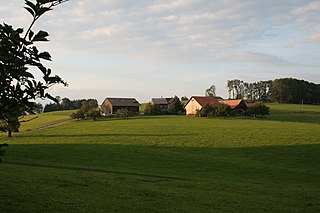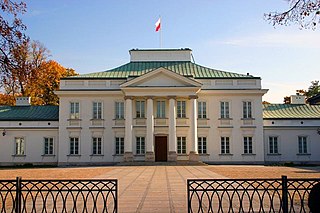
Lesser Poland Voivodeship or Lesser Poland Province, also known as Małopolska Voivodeship or Małopolska Province, is a voivodeship (province), in southern Poland. It has an area of 15,108 square kilometres (5,833 sq mi), and a population of 3,267,731 (2006).

Kraków John Paul II International Airport is an international airport located near Kraków, in the village of Balice, 11 km (6.8 mi) west of the city centre, in southern Poland. It is the second busiest airport of the country in terms of the volume of passengers served annually.

Pieskowa Skała, is a limestone cliff in the valley of river Prądnik, Poland, best known for its Renaissance castle. It is located within the boundaries of the Ojców National Park, 27 km north of Kraków, near the village of Sułoszowa. The castle was first mentioned in Latin documents of Polish king Władysław I the Elbow-high before 1315, as "castrum Peskenstein".

Brzesko is a town in southern Poland, in Lesser Poland Voivodeship. It lies approximately 25 kilometres (16 mi) west of Tarnów and 50 kilometres (31 mi) east of the regional capital Kraków. Since Polish administrative reorganization, Brzesko has been the administrative capital of Brzesko County in Lesser Poland Voivodeship. Before reorganization it was part of Tarnów Voivodeship (1975–1998).
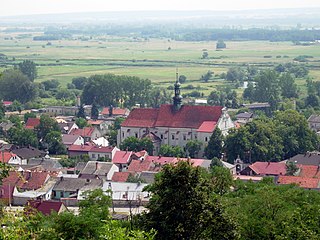
Pińczówpronounced [ˈpʲiɲt͡ʂuf] is a town in Poland, in Świętokrzyskie Voivodeship, about 40 km south of Kielce. It is the capital of Pińczów County. Population is 12,304 (2005). Pińczów belongs to the historic Polish province of Lesser Poland, and lies in the valley of the Nida river. The town has a station on a narrow-gauge line, called Holy Cross Mountains Rail
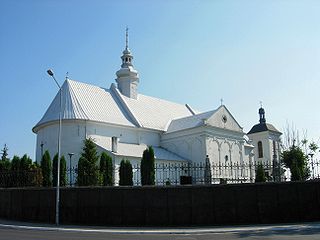
Kazimierza Wielka is a town in Poland, in Świętokrzyskie Voivodeship, about 45 kilometres northeast of Kraków. It is the administrative seat of Kazimierza County. With a population of 5,848 (2005), it is the smallest county seat in Poland. Kazimierza Wielka is located in Lesser Poland Upland and historically belongs to the province of Lesser Poland. For most of its history, it was a village, and did not receive its town charter until 1959.

Town Hall Tower in Kraków, Poland is one of the main focal points of the Main Market Square in the Old Town district of Kraków.

Okocim Brewery, in Brzesko in southeastern Poland, is a brewery founded in 1845.
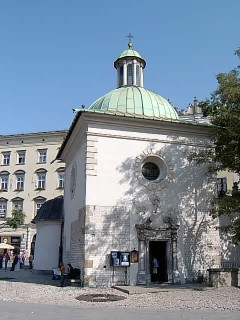
The Church of St. Adalbert or the Church of St. Wojciech, located on the intersection of the Main Market Square and Grodzka Street in Old Town, Kraków, is one of the oldest stone churches in Poland. Its almost 1000-year-old history goes back to the beginning of the Polish Romanesque architecture of the early Middle Ages. Throughout the early history of Kraków the Church of St. Wojciech was a place of worship first visited by merchants travelling from across Europe. It was a place where citizens and nobility would meet.

Bucze is a village in the administrative district of Gmina Brzesko, within Brzesko County, Lesser Poland Voivodeship, in southern Poland. It lies approximately 8 kilometres (5 mi) north of Brzesko and 48 km (30 mi) east of the regional capital Kraków.

Rajsko is a village in the administrative district of Gmina Oświęcim, within Oświęcim County, Lesser Poland Voivodeship, in southern Poland. It lies approximately 7 kilometres (4 mi) south-west of Oświęcim and 55 km (34 mi) west of the regional capital Kraków.

Hebdów is a village in the administrative district of Gmina Nowe Brzesko, within Proszowice County, Lesser Poland Voivodeship, in southern Poland. It lies approximately 3 kilometres (2 mi) north-east of Nowe Brzesko, 10 km (6 mi) south-east of Proszowice, and 36 km (22 mi) east of the regional capital Kraków.

Nowe Brzesko is a town in Proszowice County, Lesser Poland Voivodeship, in southern Poland. It is the seat of the gmina called Gmina Nowe Brzesko. It lies approximately 10 kilometres (6 mi) south-east of Proszowice and 33 km (21 mi) east of the regional capital Kraków. According to 2011 official census Nowe Brzesko has population of 1662. It gained town rights in 1279, but lost that status in 1870 by decree of the Russian tsar. It became a town again on 1 January 2011.

Sturehov Manor is a manor house in Botkyrka Municipality, a suburb of Stockholm, Sweden. The manor contains well-preserved 18th-century interiors.

The city of Kraków is divided into 18 administrative districts, each with a degree of autonomy within the municipal government. The Polish name for such a district is dzielnica.

The Palace of the Kraków Bishops in Kielce, was built in the 17th century as a summer residence of Bishops of Kraków in Kielce, Poland. The architecture of the palace constitute a unique mélange of Polish and Italian traditions and reflects political ambitions of its founder. Currently the palace houses a branch of the National Museum with an important gallery of Polish paintings.

Kurozwęki Palace is a Baroque-Classical residence in Kurozwęki, Poland.
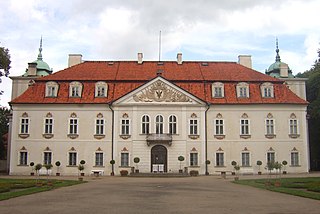
Nieborów Palace is an aristocratic residence located in the village of Nieborów in Poland. Built in the 17th century by one of the greatest Baroque architects, the Dutchman Tylman van Gameren, the building belongs to one of the most renowned Poland's aristocratic residences and serves as a museum of interior design of palace residences from the 17th to the 19th century, based on the surviving furniture and collections, featuring portraits of eminent personalities of the era, several thousand drawings and sketches, books, porcelain and textiles.

The Palazzo Orsini di Gravina is a Renaissance-style palace on number 3 Via Monteoliveto, in the San Lorenzo quarter of Rione San Giuseppe-Carità, of central Naples, Italy. Since 1940, it has housed the Faculty of Architecture of the University of Naples. It is located across the street and a few doors north of the sleek and modern Palazzo delle Poste. Across the street at the north end of the palace, is the Piazza Monteoliveto with its Fountain and the church of Sant'Anna dei Lombardi.


